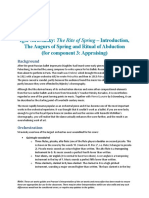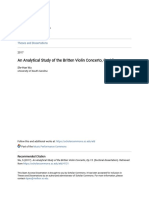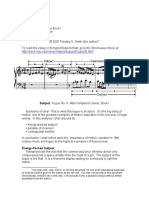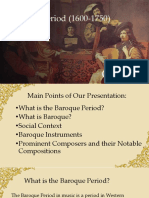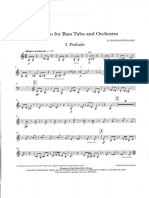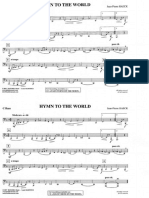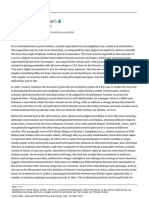Slur
Slur
Uploaded by
張顥嚴Copyright:
Available Formats
Slur
Slur
Uploaded by
張顥嚴Copyright
Available Formats
Share this document
Did you find this document useful?
Is this content inappropriate?
Copyright:
Available Formats
Slur
Slur
Uploaded by
張顥嚴Copyright:
Available Formats
Slur [bind]
Slur [bind]
Geoffrey Chew
https://doi.org/10.1093/gmo/9781561592630.article.25977
Published in print: 20 January 2001
Published online: 2001
In musical notation, a curved line (or square bracket etc.) extending over or under a succession of notes to
indicate their grouping as a coherent unit, for example in legato performance, or for purposes of phrasing.
The term is also applied to the musical effect associated with the notational slur, which is invariably a
sense of coherence and continuity. In general, on string instruments, all notes grouped under a slur are
taken within one stroke of the bow if possible, whilst for wind players and vocalists, slurs serve to some
extent as breathing instructions.
The earliest form of the slur was the Tie, a term used only for slurs between notes of the same pitch, even if
differently spelt, for example A♭ to G♯. In the 16th century, keyboard music, in which bar-lines were used,
required some such device in order to permit the notation of chords or notes extending beyond the bar-
line; the tie was not otherwise necessary at the time, since the note durations in the 16th-century
repertory could all be expressed in terms of single notes, dotted or undotted. The earliest source containing
ties is Cavazzoni’s Recerchari, motetti, canzoni … libro primo (1523). Generally speaking the tie has continued
to be used exclusively for notes that are not to be repeated, except when the first of the two notes tied is
qualified by a staccato dot, when the tie is sometimes converted into a slur in the broader sense, and the
second note is to be sounded and grouped with the first (as in ex.1).
Ex.1 Liszt: Consolations for piano, no.6
No general need has ever been felt to eliminate the few possible ambiguities in the use of slur and tie, but
Matthay (1928) claimed that a notated slur between two notes of the same pitch was a tie only when it
joined the note-heads, but a slur when it joined the ends of the stems; and Sterndale Bennett
recommended the use of a squared slur-mark to distinguish the tie (ex.2, from Stainer and Barrett:
Dictionary of Musical Terms, 1898, p.58).
Page 1 of 4
Printed from Grove Music Online. Grove is a registered trademark. Under the terms of the licence agreement, an
individual user may print out a single article for personal use (for details see Privacy Policy).
Subscriber: National Taiwan Normal University; date: 03 May 2022
Slur [bind]
Ex.2
In the 17th century the slur between notes of different pitches took on the function earlier fulfilled by
ligatures, since no ligature signs existed to join minims or smaller note values to each other (Praetorius:
Syntagma musicum, iii, 2/1619). It is commonly used in 17th-century vocal music, with all the notes to be
sung to a single syllable slurred (and often beamed) together. In this context the slur may be regarded as a
type of ornament (see Ornaments, §8); no connotations of phrasing etc. are normally intended.
Surprisingly, this conventional vocal notation has survived all notational reforms, and it is still used in
most vocal music. From the 17th century the slur was also used in instrumental music, broadly with its
modern meanings of bowing (John Playford: A Breefe Introduction, 7/1674, p.36), breathing or tonguing.
Such symbols are not at this date used rigorously or systematically, however, and must be interpreted with
some latitude (for the use of the slur to indicate various types of bowstroke, see Bow, §II).
In some Baroque music, the slur carries rhythmic connotations. Couperin, by dotting the second of pairs of
slurred quavers, indicated that they were to be played unequally, short–long; but the device is uncommon.
A slur over several notes may indicate that they are to be played equally rather than as notes inégales.
From the 18th century, the slur, over white-note keyboard scales, may indicate glissando (as in ex.3);
vertical slurs beside chords indicate that the chords are to be broken; and slurs over melodies generally
indicate legato – the most frequent use of the sign in the period 1750–1850. Such legato slurs may be
longer than in modern practice, for example in string music; or they may be shorter, for example, broken
at the ends of bars without implying corresponding breaks in the legato. Some composers, such as Mozart,
were more precise than others in their use of the slur, but no composer of this period used it precisely in
accordance with post-Riemann practice (ex.3).
Page 2 of 4
Printed from Grove Music Online. Grove is a registered trademark. Under the terms of the licence agreement, an
individual user may print out a single article for personal use (for details see Privacy Policy).
Subscriber: National Taiwan Normal University; date: 03 May 2022
Slur [bind]
Ex.3 Weber: Concertstück op.79 (1823 edn)
To speak of phrasing slurs before the second half of the 19th century is, strictly, anachronistic: it was only
during that century that the beginnings and ends of slurs came invariably to carry their modern
connotations of the beginnings and ends of phrases (first, according to Matthay, in the music of Joachim
Raff). In consequence, Hugo Riemann believed that the notation of Haydn, Mozart, Beethoven and others
was by now misleading and in need of radical revision; and he brought the slur into the service of phrasing
theory (see Articulation and phrasing). In his phrasing editions, in particular, Riemann used the slur (as
well as the beam and other devices) to mark off Motive and their multiples and submultiples: these are
defined in his Musikalische Dynamik und Agogik (1884) as basic rhythmic units of phrasing, each normally
comprising a growth phase and a decay phase and each implying a subtle use of dynamics and agogics.
Riemann’s Motiv includes all that is normally implied in the modern term ‘phrase’, and more: some of the
Motive in his editions, duly marked off with slurs, comprise only rests.
Schenker’s reaction against the phrasing editions of Riemann and others (1925) took the form of a plea for
a return to the Urtext and, with it, the ‘non-phrasing’ slur, connoting only legato. At the same time,
Schenker’s graphic analyses of tonal works use the slur for novel purposes: the groupings of Züge, or
melodic progressions within the part-writing. Other novel types of slur in the 20th century include the
Page 3 of 4
Printed from Grove Music Online. Grove is a registered trademark. Under the terms of the licence agreement, an
individual user may print out a single article for personal use (for details see Privacy Policy).
Subscriber: National Taiwan Normal University; date: 03 May 2022
Slur [bind]
square bracket in editions of early music to indicate the presence of ligatures in the original source (with
variations to indicate coloration), and graphically modified forms also to distinguish slurs added
editorially from those in the original.
Bibliography
M. Lussy: Traité de l’expression musicale (Paris, 1874, 8/1904; Eng. trans., 1885)
H. Riemann: Musikalische Dynamik und Agogik: Lehrbuch der musikalischen Phrasirung (Hamburg, 1884)
S. Macpherson: Studies in Phrasing and Form (London, 1911, 2/1932)
H. Schenker: ‘Weg mit dem Phrasierungsbogen’, Das Meisterwerk in der Musik, 1 (Munich, 1925/R), 41–60; Eng. trans.
(Cambridge, 1994), 20–30
H. Keller: Phrasierung und Artikulation (Kassel, 1955; Eng. trans., 1965/R)
E. and P. Badura-Skoda: Mozart-Interpretation (Vienna and Stuttgart, 1957; Eng. trans., 1962/R as Interpreting Mozart
on the Keyboard)
W.S. Newman: ‘Some Articulation Puzzles in Beethoven’s Autographs and Earliest Editions’, IMSCR XI: Copenhagen
1972, 580–85
B. Ganz: ‘Von den geschleiften und den gestossenen Tönen in der Claviermusik des 18. Jahrhunderts’, SMz, 114 (1974),
205–14
D. Barnett: ‘Non-Uniform Slurring in 18th-Century Music: Accident or Design?’, Haydn Yearbook 1978, 179–99
P. Farrell: ‘On the Use of Slurs in English Viol Music’, JVdGSA, 16 (1979), 5–21
B. Gustafson: ‘Shapes and Meanings of Slurs in Unmeasured Harpsichord Preludes’, French Baroque Music, 2 (1984),
20–22
C. Schachter: ‘20th-Century Analysis and Mozart Performance’, EMc, 19 (1991), 620–24
See also
Notation, §III, 4(iv): Mensural notation from 1500: The joining and separation of notes
Page 4 of 4
Printed from Grove Music Online. Grove is a registered trademark. Under the terms of the licence agreement, an
individual user may print out a single article for personal use (for details see Privacy Policy).
Subscriber: National Taiwan Normal University; date: 03 May 2022
You might also like
- Beethoven Symphony No. 5, Mvt. 1 - DevelopmentDocument8 pagesBeethoven Symphony No. 5, Mvt. 1 - DevelopmentBilly James St JohnNo ratings yet
- Fenaroli RegimenDocument4 pagesFenaroli RegimenMichael Free100% (1)
- Program Notes French SuiteDocument2 pagesProgram Notes French Suitewaterwood3388No ratings yet
- Kirkpatrick (1976) - C. P. E. Bach - S Versuch ReconsideredDocument10 pagesKirkpatrick (1976) - C. P. E. Bach - S Versuch ReconsideredivancbaNo ratings yet
- #26 Evolucion Del SoundholeDocument65 pages#26 Evolucion Del SoundholerodolfoNo ratings yet
- ScarlattiDocument22 pagesScarlattiSergio Rodríguez MolinaNo ratings yet
- Payne Teleman and Bach Evidence BorrowingDocument24 pagesPayne Teleman and Bach Evidence BorrowingShuntaro SugieNo ratings yet
- Albeniz and His MusicDocument11 pagesAlbeniz and His Musicadorno5No ratings yet
- MUSIC 415 Final PaperDocument11 pagesMUSIC 415 Final PaperMatthew ChanNo ratings yet
- With, or Without Nails?: © Gérard REBOURS 2001Document4 pagesWith, or Without Nails?: © Gérard REBOURS 2001Andrey BalalinNo ratings yet
- MozartDocument8 pagesMozartcarloskohatsuNo ratings yet
- CPEBach BookletDocument32 pagesCPEBach BookletMiguel100% (1)
- Franck-Variations Symphoniques For Piano and OrchestraDocument2 pagesFranck-Variations Symphoniques For Piano and OrchestraAlexandra MgzNo ratings yet
- Texts of Choral Wor 03 BachDocument210 pagesTexts of Choral Wor 03 BachWascawwy WabbitNo ratings yet
- PDFDocument363 pagesPDFLeandro Rafael MendozaNo ratings yet
- Anon., 1100-1500 (Middle English Lyrics and Ballads) : 1 EARTH UPON EARTH (From The Harley Lyrics (1964) )Document48 pagesAnon., 1100-1500 (Middle English Lyrics and Ballads) : 1 EARTH UPON EARTH (From The Harley Lyrics (1964) )jooooooeyNo ratings yet
- English Suite No. 1 in A Major, BMV 806Document6 pagesEnglish Suite No. 1 in A Major, BMV 806Macoi BalbinNo ratings yet
- Program Notes: 1. 2 Preludes by A. Scriabin (Arr: A. Fougeray)Document3 pagesProgram Notes: 1. 2 Preludes by A. Scriabin (Arr: A. Fougeray)AlmeidaNo ratings yet
- The Not-So-Precisely Measured Music of The Middle AgesDocument20 pagesThe Not-So-Precisely Measured Music of The Middle AgesConstanza Bustos100% (1)
- Malcolm Arnold PDFDocument2 pagesMalcolm Arnold PDFAlessio CaloreNo ratings yet
- BIS 1014 Booklet X.PDF 6ff3e7Document28 pagesBIS 1014 Booklet X.PDF 6ff3e7Paulo RamosNo ratings yet
- Andrea Gabrieli - Missa Pater PeccaviDocument16 pagesAndrea Gabrieli - Missa Pater PeccaviSebastian SamerNo ratings yet
- Heinrich Nikolaus Gerber'sDocument22 pagesHeinrich Nikolaus Gerber'sPerez Zarate Gabriel MarianoNo ratings yet
- Texts of Choral Wor 01 BachDocument232 pagesTexts of Choral Wor 01 BachWascawwy WabbitNo ratings yet
- AP080 - BookletDocument28 pagesAP080 - BookletddNo ratings yet
- Claude Debussy - Harmonic Innovations in Historical and Musical CoDocument24 pagesClaude Debussy - Harmonic Innovations in Historical and Musical CoIvan Canedo100% (1)
- Metre in Unmeasured PreludesDocument7 pagesMetre in Unmeasured PreludesCarloV.Arruda100% (1)
- Analysis Haydn 85 MinuetDocument16 pagesAnalysis Haydn 85 MinuetLucas Isaias Di BenedettoNo ratings yet
- Canon Inv CTPT PDFDocument8 pagesCanon Inv CTPT PDFrizgar774813100% (1)
- The Contribution of Guido of Arezzo To Western Music TheoryDocument6 pagesThe Contribution of Guido of Arezzo To Western Music TheoryPeter JoyceNo ratings yet
- French Baroque Music - From Beaujoyeulx To RameauDocument48 pagesFrench Baroque Music - From Beaujoyeulx To RameauFirasNo ratings yet
- Debussy Préludes: Books I & IIDocument24 pagesDebussy Préludes: Books I & IIcudankaNo ratings yet
- Notes On Playing ContinuoDocument4 pagesNotes On Playing ContinuoNuno OliveiraNo ratings yet
- A Level Stravinsky Set Work Support GuideDocument6 pagesA Level Stravinsky Set Work Support GuideDora GaitanoviciNo ratings yet
- Franz Schubert Chamber Music PresentationDocument3 pagesFranz Schubert Chamber Music PresentationLia CriscuoloNo ratings yet
- Text, Form, and Style in Franchino Gaffurio's Motetes - Daniel v. Flippi (2012)Document32 pagesText, Form, and Style in Franchino Gaffurio's Motetes - Daniel v. Flippi (2012)SandGeorge100% (1)
- Bonnet Bossi Karg ElertDocument8 pagesBonnet Bossi Karg ElertdurufleNo ratings yet
- Index of Analyzed FuguesDocument21 pagesIndex of Analyzed FuguesNicky AlejandrinoNo ratings yet
- An Analytical Study of The Britten Violin Concerto Op.15Document67 pagesAn Analytical Study of The Britten Violin Concerto Op.15Daddo Marzoli100% (1)
- Fugue No. 6: Well-Tempered Clavier Book IDocument4 pagesFugue No. 6: Well-Tempered Clavier Book IsadhanaNo ratings yet
- Federico MompouDocument3 pagesFederico MompouSergio Miguel Miguel0% (1)
- P57-2 II Vivaldis Music-Style and FormDocument155 pagesP57-2 II Vivaldis Music-Style and Formvincersestesso100% (1)
- Mendelssohn PaperDocument11 pagesMendelssohn Paperapi-406972706No ratings yet
- PHD Masumi Yamamoto PDFDocument159 pagesPHD Masumi Yamamoto PDFFernando Cayres Morino100% (1)
- Johann Sebastian Bach: The Life and Works ofDocument17 pagesJohann Sebastian Bach: The Life and Works ofsimone zemoNo ratings yet
- Johann PachelbelDocument43 pagesJohann PachelbelAntonio BaptistaNo ratings yet
- Giovanni Pierluigi Da Palestrina A Guide To Research by Clara MarvinDocument497 pagesGiovanni Pierluigi Da Palestrina A Guide To Research by Clara MarvinGonzalo Pastrana CárdenasNo ratings yet
- BachDocument5 pagesBachbeebeeheNo ratings yet
- Monteverdi Clorinda e TancrediDocument19 pagesMonteverdi Clorinda e TancrediFelipeCussenNo ratings yet
- The Place of Improvisation in Classical Guitar - LRDocument4 pagesThe Place of Improvisation in Classical Guitar - LRAlmeidaNo ratings yet
- Impro BasicKit WebDocument14 pagesImpro BasicKit Webfinvest2005100% (1)
- Galilei, Michelangelo - Primo LibroDocument76 pagesGalilei, Michelangelo - Primo LibroLeandro MarquesNo ratings yet
- Johannes Ockeghem The Changing Image, The Songs and A New SourceDocument15 pagesJohannes Ockeghem The Changing Image, The Songs and A New Sourcetrabajos y tareas urabá100% (1)
- Baroque ReportDocument32 pagesBaroque ReportMVS100% (1)
- Johann Sebastian BachDocument18 pagesJohann Sebastian Bachj.miguel593515100% (1)
- Generation of Instrument Makers Has Grown Up WithDocument5 pagesGeneration of Instrument Makers Has Grown Up Withyaroslav88No ratings yet
- Roi David HoneggerDocument9 pagesRoi David HoneggermordidacampestreNo ratings yet
- QuaroDocument66 pagesQuaro張顥嚴No ratings yet
- 1Document1 page1張顥嚴No ratings yet
- 4Document1 page4張顥嚴No ratings yet
- 08 - R.V.Williams Tuba Concerto - HN - IIDocument6 pages08 - R.V.Williams Tuba Concerto - HN - II張顥嚴No ratings yet
- 05 R.v.williams Tuba Concerto CL - IIDocument9 pages05 R.v.williams Tuba Concerto CL - II張顥嚴No ratings yet
- 07 R.v.williams Tuba Concerto Hn.IDocument6 pages07 R.v.williams Tuba Concerto Hn.I張顥嚴No ratings yet
- OboeDocument1 pageOboe張顥嚴No ratings yet
- C BassDocument1 pageC Bass張顥嚴No ratings yet
- 09 R.v.williams Tuba Concerto Tp.IDocument5 pages09 R.v.williams Tuba Concerto Tp.I張顥嚴No ratings yet
- Snare DrumDocument1 pageSnare Drum張顥嚴No ratings yet
- LegatoDocument2 pagesLegato張顥嚴No ratings yet
- TenutoDocument1 pageTenuto張顥嚴No ratings yet
- FluteDocument2 pagesFlute張顥嚴No ratings yet
- ExpressionDocument21 pagesExpression張顥嚴No ratings yet
- StaccatoDocument2 pagesStaccato張顥嚴No ratings yet
- AgogicDocument3 pagesAgogic張顥嚴No ratings yet
- Non-Harmonic NoteDocument3 pagesNon-Harmonic Note張顥嚴No ratings yet

































